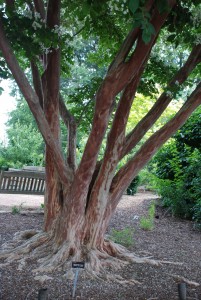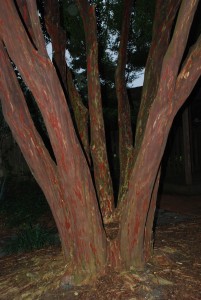Most crape myrtle cultivars marketed through garden centers are hybrids that combine the large colorful flowers of Common Crape myrtle (Lagerstroemia indica) with the mildew-resistant foliage and cold hardiness of Japanese Crapemyrtle (L. faurei). Japanese Crape myrtle are cold hardy (USDA hardiness zones 6-b to 9) and are heat tolerant. They are rated hardy to winter minus 10 ºF.
Japanese Crape myrtle is a multi-stemmed, medium 40 foot tree deciduous tree. At the JC Raulston Arboretum (JCRA) in Raleigh, NC, the cultivar ‘Fantasy’ is 50 feet tall after 30+years. It flaunts a stunning flaking cinnamon brown bark. In my opinion, it’s the showiest of all crape myrtles. A close second is a 40 foot tall ‘Townhouse’ with a dark chocolate bark. Fantasy is rated less cold hardy than Townhouse.
Japanese Crape myrtle produces abundant pure white flower clusters averaging 4 inches in diameter. Compared to most other crape myrtles, flower clusters are looser than those of L. indica that do not droop as much following heavy rains. Tree blooms only once, usually in early summer in Tennessee, Virginia, and North Carolina.
Main multi-stemmed trunk grows upright with tips of branches slightly nodding, and rounded crown. It grows best in full sun and in moist fertile soil. It tolerates dry soils once established after 1 year. Do not plant on public lands, particularly non-irrigated sites such as highway medians, urban streets, and parking lots. Feed in early spring with a slow release fertilizer. Annual mulching around trees is highly recommended.
After flowering, Japanese crape myrtle grows through the summer and, in some years has trouble hardening off before winter. To prevent early frost injury, do not fertilize after mid-summer. Flowers are smaller compared to hybrid cultivars.
Compared with hybrid cultivars, Japanese crape myrtle is susceptible to aphids, scale, and powdery mildew. Its leaves are highly mildew resistant.



 Posted in
Posted in 
